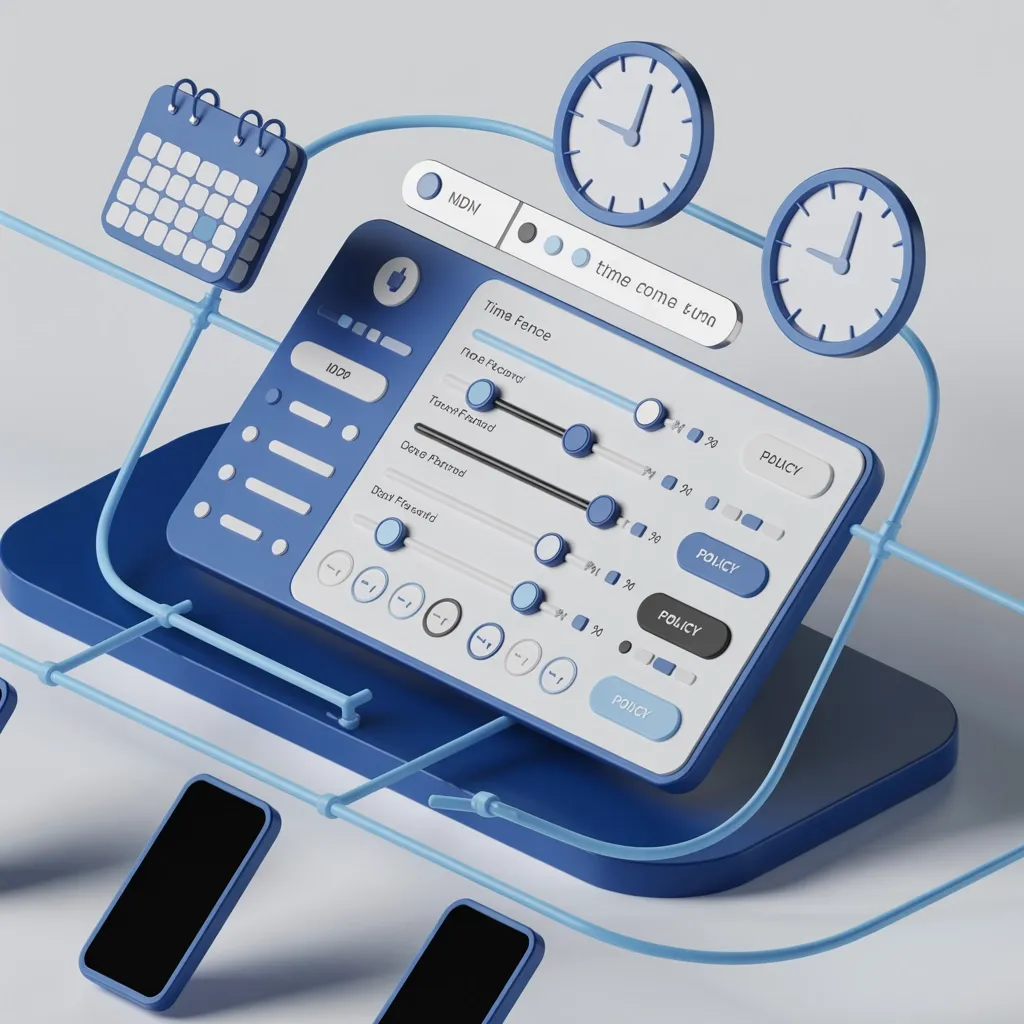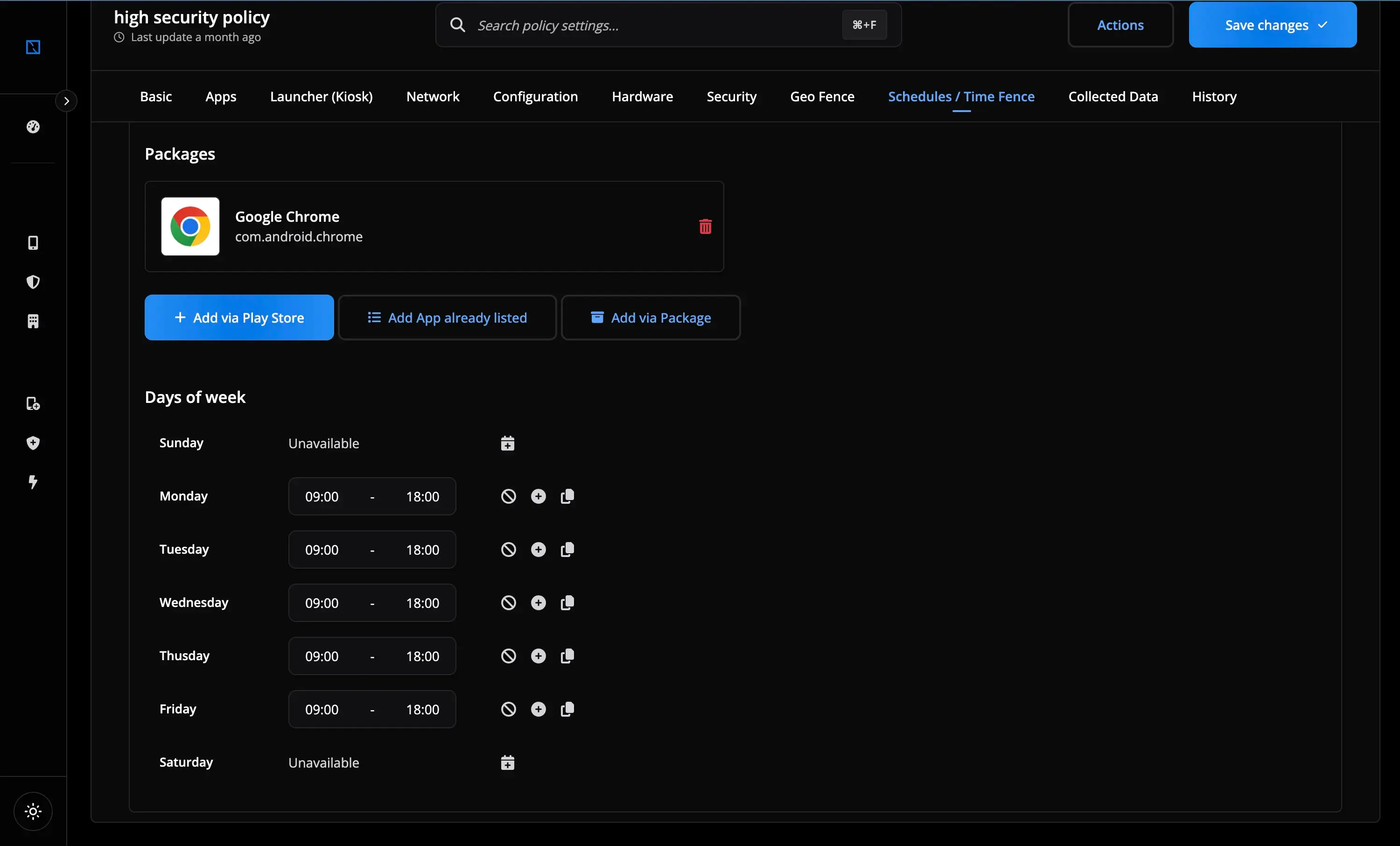What Is a Time Fence in Mobile Device Management?
In the world of Mobile Device Management (MDM), a time fence is a powerful policy feature that allows administrators to control when devices can be used based on specific time parameters. Think of it as a virtual boundary defined by time rather than location. While geofencing restricts device usage based on physical location, time fencing restricts usage based on time schedules.
Time fences enable organizations to enforce usage policies by creating time-based rules that automatically apply restrictions during specified periods. This helps maintain productivity, ensure compliance, and enhance security across your device fleet.

How Do Time Fences Work?
Time fences function by allowing MDM administrators to create time-based profiles that define when certain device features, applications, or functions are available or restricted. Once configured, these policies are pushed to enrolled devices and automatically enforced according to the schedule.
A time fence policy typically includes:
- Days of the week: Select which days the policy applies (e.g., weekdays only, weekends only, or specific days)
- Time ranges: Define specific hours when restrictions are active
- Time zones: Account for devices operating across different geographical regions
- Actions or restrictions: Determine what happens when a device enters or exits the defined time period
For example, a school might create a time fence that blocks gaming apps during class hours (8 AM to 3 PM, Monday through Friday) but allows them outside of these hours. Similarly, a company might restrict access to certain corporate resources outside of business hours to enhance security.
Key Benefits of Implementing Time Fences
1. Enhanced Productivity
Time fences allow organizations to minimize distractions during work or school hours by restricting access to non-essential applications or websites. By setting specific time parameters, administrators can ensure that devices are used for their intended purposes during critical periods, increasing focus and productivity.
2. Improved Work-Life Balance
For organizations with BYOD (Bring Your Own Device) policies or company-issued devices that employees take home, time fences can help establish clear boundaries between work and personal time. By automatically disabling work applications after hours, organizations can promote healthier work-life balance and reduce burnout.
3. Stronger Security Posture
Time fences contribute significantly to an organization's security strategy by limiting access to sensitive data during non-business hours when suspicious activities are more likely to occur. This time-based restriction adds another layer of protection against unauthorized access and potential data breaches.

4. Resource Optimization
By controlling when devices can perform certain functions, organizations can manage network bandwidth and resource utilization more effectively. For instance, system updates or large data synchronizations can be scheduled during off-peak hours to prevent network congestion.
5. Compliance Support
Many industries have regulations regarding work hours, overtime, and digital accessibility. Time fences help organizations maintain compliance by automatically enforcing these regulations through technology rather than relying solely on manual oversight.
Real-World Applications of Time Fences
Education Sector
Schools and educational institutions can implement time fences to:
- Block gaming and social media apps during class hours
- Allow educational apps only during school hours
- Restrict device usage during overnight hours for boarding schools
- Enable different policies for exam periods versus regular class days
For example, a high school using Nomid MDM can configure tablets to only access educational resources from 8 AM to 3 PM on weekdays, while allowing broader access during study hall periods and weekends.
Healthcare Environments
Healthcare organizations benefit from time fences by:
- Limiting access to patient records during off-hours
- Enforcing quiet hours on shared devices in patient areas
- Scheduling automatic updates during lowest-activity periods
- Creating different access protocols for day and night shifts
A hospital might configure their mobile device fleet to restrict certain high-alert notifications during patient sleeping hours while maintaining critical alert functionality for the nursing staff.
Retail and Service Industries
Businesses with frontline workers can use time fences to:
- Lock down point-of-sale devices after business hours
- Enable specific applications only during shift hours
- Prevent after-hours access to inventory systems
- Create different device behaviors for opening, regular, and closing shifts
Corporate Environments
Enterprises can leverage time fences to:
- Restrict access to sensitive corporate data outside of business hours
- Disable work email notifications during evenings and weekends
- Allow VPN connections only during work hours
- Create special access windows for maintenance and updates

How to Implement Time Fences with Nomid MDM
Nomid MDM makes it straightforward to create and manage time fence policies across your device fleet. Here's a simplified process of how to implement time fences:
1. Navigate to Policy Management: Log in to your Nomid MDM dashboard and access the policy management section.

2. Create a New Time Fence Config: Once you are inside the policy you want to edit, click on the "Time Fence" tab to navigate to the time fence section, and then click on "Add Configuration".

3. Define Time Parameters And Restrictions: Specify the days of the week and time ranges when your time fence should be active. Block specific applications. Remember to consider time zones if managing devices across different regions.

4. Deploy and Monitor: Push the policy to devices and monitor compliance through the dashboard.
Check a more detailed article in our Wiki
Best Practices for Time Fence Implementation
1. Start with Clear Objectives
Before implementing time fences, define clear objectives for what you want to achieve. Are you focusing on productivity, security, compliance, or a combination? Having clear goals will help you design more effective policies.
2. Consider User Experience
While restrictions are necessary, consider the impact on user experience. Overly restrictive policies may frustrate users and lead to workarounds or resistance. Strike a balance between security and usability.
3. Communicate Policies Clearly
Ensure that all users understand when and why certain restrictions are in place. Transparent communication helps reduce support tickets and increases policy acceptance.
4. Account for Exceptions
Plan for exceptions in advance. Some users may legitimately need access outside normal hours. Nomid MDM allows you to create exception groups or temporary overrides for these situations.
5. Regularly Review and Update
Time fence policies should be reviewed regularly to ensure they still align with organizational needs. As work patterns evolve, your time-based restrictions may need adjustment.
6. Combine with Other Security Measures
Time fences work best as part of a comprehensive security strategy. Combine them with other MDM features like geofencing, app management, and device encryption for a more robust security posture.
Conclusion
Time fences represent a powerful yet flexible tool in the MDM toolkit, allowing organizations to enforce time-based policies that enhance security, productivity, and compliance. By creating clear boundaries around when and how devices can be used, Nomid MDM helps organizations maintain control over their mobile device fleets while respecting the needs of users.
Whether you're managing devices in an educational setting, healthcare environment, retail operation, or corporate office, implementing time fences can significantly improve your device management strategy. With Nomid MDM's intuitive interface and robust feature set, creating and managing time fence policies becomes a straightforward process that delivers immediate benefits across your organization.
Ready to implement time fences in your organization?
Contact our team today to learn more about how Nomid MDM can help you leverage time-based policies for better device management.
Schedule a DemoShare this article
Tags
- #mdm
- #time-fence


